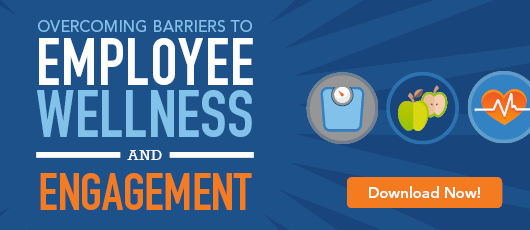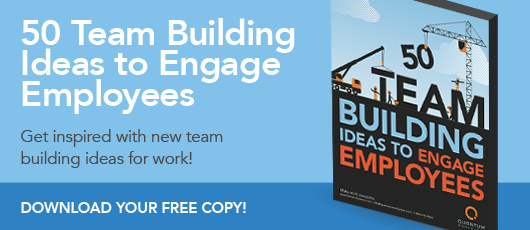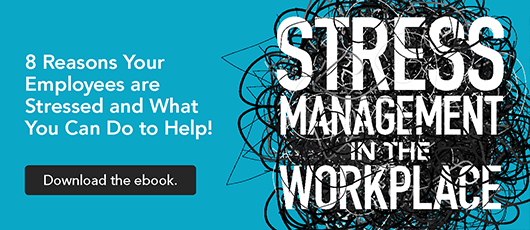7 Simple Ways to Reduce Stress in the Workplace
 Stress is one of the most daunting obstacles to employee engagement in the modern workplace.
Stress is one of the most daunting obstacles to employee engagement in the modern workplace.
Studies estimate that stress costs U.S. businesses an estimated $300 billion annually, and the workplace has been identified as the number one source of stress for American workers.
Workload, lack of job security, and personnel problems gang up on and overwhelm employees, dragging down their satisfaction levels. In fact, the negative consequences from stress are so strong that it has been declared a World Wide Epidemic by the World Health Organization.
While many have tried to construct all-encompassing lists of stress reduction tactics, recent studies have shown there is no one-size-fits-all approach.
In the workplace, employee-environment fit should be the primary focus. If it's a good match, the employee is likely to be relaxed. A poor fit increases tension and stress.
As managers and companies, we need to examine our employees and the environments we create for them. We need to make sure we are providing an office that fits our employees' definition of “not stressful,” not just what we think that looks like.
We have a few broad ideas that can be used to alleviate workplace stress, but make sure you tailor them to your workforce. Put these ideas into action; and remember, the best strategies start with leadership’s example.
1. Encourage workplace wellness.
Exercise and healthy living are two of your best weapons against workplace stress. Exercise takes employees' minds off the stress of their job to focus on the task at hand. It also improves moods by increasing the production of endorphins, the brain's feel-good neurotransmitters.
- Encourage employees to go on a walk during lunch breaks
- Subsidize gym memberships
- Bring a yoga instructor into the office once a month
- Hold a steps contest among teams for those who own fitness trackers
- Offer healthy snacks in the office
Employees feel valued when they think you're looking out for their health! A study by Peapod.com reported that 66% of employees felt extremely or very happy when their employer regularly stocked the refrigerator and cupboards, and 83% said that having healthy and fresh snack options was a huge perk. Something as simple as keeping fresh fruit or cartons of yogurt in the fridge goes a long way with employees.
2. Revamp the habitat.
A lot of stress comes from environment. Think about every aspect of your office space and what it does (or doesn’t do) for the wellness of your team. Simple things like the quality of the coffee or the height of the cubicle walls can affect employee engagement.
Update the office with an upbeat color scheme, additional plants, or new silverware. If you have the space, think about adding a ping pong or foosball table to allow employees to take their mind off of their stress for a few minutes. Any changes that increase employee enjoyment will leave them feeling less stressed.
3. Allow for flexible hours and remote working.
You hired your employees because you have confidence in their ability to do their jobs well and in a timely manner—so let them prove it. Your office shouldn’t feel like a cell, but rather a place that facilitates getting a job done. Let your employees know that their job is defined by the quality and timeliness of their work, not when they punch the clock.
Allow your employees to work remotely, and give flexibility for start and end times. This freedom is great for office morale, and the policy shows employees that you trust them enough not to babysit.
4. Encourage social activity.
Employees spend a lot of time together, and the more comfortable they are, the less stress they will feel. As coworkers get to know each other, expectations and communication barriers are broken down, greasing the wheels for easier future interactions.
5. Create quiet time.
Stress can't be completely avoided, but you can help alleviate it when it arrives. Ensure your employees have a place where they can take a break.
Our research shows that more than 80 percent of disengaged and hostile employees preferred the opportunity to have stress-relief breaks, such as a nap, massage, or required break. A small room, a lounge space at the end of the hall, and even an outdoor bench can be perfect places to find refuge from the chaos of the daily grind. Think about longer, retreat-style vacations, which can serve the same purpose.
If your organization can afford to do so, consider implementing "No Meeting Mondays" or something similar, essentially blocking off time for employees to focus in on individual task and keep from getting bogged down with meetings or overwhelmed by a heavy workload.
6. Provide onsite or distance counseling.
Many companies have also begun providing counseling as a way for employees to help deal with stress; in a recent study, almost half of workers felt they needed help in learning how to handle the stresses of their jobs. This strategy—in or out of the office, in group settings or individually—can help employees prepare for what stress will come their way.
7. Recognize your employees.
Employees love being praised for a job well done, and recognizing their success results in a serious boost in engagement. Each employee has a different personality, so be mindful when considering how and when to recognize. Some employees appreciate a call-out during a meeting or praise in a company-wide email, while more reserved types might prefer a card on their desk or a thank you in person.
However you choose to recognize, your employees will appreciate that you are aware off their success and want to share it with others. This makes them happier and more comfortable, in turn lowering stress levels.
Looking for more research on employee stress and what employers can do to reduce it? Download our ebook, Stress Management in the Workplace.









